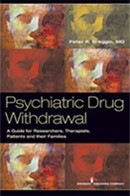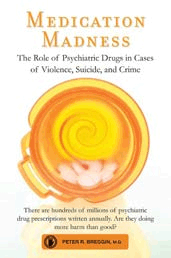What Should We Really Call Psychiatric Drugs?
There is a single scientific term that most appropriately describes psychiatric drugs. Not long ago, I used it in court on several occasions during my testimony to explain why psychiatric drugs can have such disastrous effects on the brain, mind, and behavior.
My use of the term angered experts on the other side who declared, in effect, “if you search the scientific literature, only Dr. Breggin uses that word to describe psychiatric drugs.” In fact, there is a long tradition of using the dread word that has been largely expunged from the official psychiatric literature but remains alive in research and at times pops up in the clinical literature.
The dread word, which I urge everyone to start using on a regular basis, is neurotoxin. The word “neurotoxin” so unhinges my colleagues because it is a true descriptor for every psychiatric chemical and because it opens the door to an honest analysis of how these poisons impact on the human brain and mental life.
What is a Neurotoxin?
A toxin is “any substance poisonous to an organism.” A neurotoxin is “a substance that alters the structure or function of the nervous system.” A similar alternative definition for neurotoxinis is “a poisonous substance that acts on the nervous system and disrupts the normal function of nerve cells.” Medically, a neurotoxin is “any toxin that acts specifically on nervous tissue.”1
There is no rational way to argue against putting psychiatric chemicals into the category of neurotoxins. All psychiatric substances alter “the structure or functions of the nervous system” and disrupt “the normal function of nerve cells.” All of them act “specifically on nervous tissue.”
How Drug Companies Seek to Create Psychiatric Neurotoxins
Drug companies tailor their future products to disrupt and alter the brain functions of normal animals before they begin to test them on humans. When a potential psychiatric drug fails to alter, disrupt or impair normal function in the mammalian brain, the drug companies discard it as useless for a psychiatric treatment.
Prozac, for example, resulted from an intense search for a chemical that would disrupt the normal functioning of serotonin neurotransmission in the animal and human brain. Similarly, it is not a coincidence that all “antipsychotic” drugs disrupt dopamine neurotransmission in the animal and human brain.
The biochemical aim of all psychiatric drugs is disruption of normal neurotransmission in the brain. The first great psychiatric researchers, Delay and Deniker, knew this and openly discussed the neurotoxic effects of the drugs that started the revolution in psychiatry in the 1950s, including Thorazine (chlorpromazine) and Haldol (haloperidol).
Denial of Neurotoxicity
The problem for modern psychiatry is that use of this dread word, neurotoxin, at the least undoes the naïve or fraudulent assumption that psychiatric drugs are relatively safe and that they do more good than harm. Accepting that all psychiatric drugs are neurotoxins makes ridiculous all claims about psychiatric drugs “correcting biochemical imbalances,” “enhancing neurotransmitters,” or “treating illnesses.” When taking a neurotoxin in sufficient doses to observably change human mental life and behavior, there is little or no chance that the benefits exceed the risks, even in the short term, and there is a near certainty of some degree of persisting harm after months and years of exposure.
By calling psychiatric drugs neurotoxins, we make clear that they are not inherently therapeutic and that their effects probably result from harming brain function. Based on what we know about neurotoxins in general, from nerve gas to antipsychotic drugs, calling them neurotoxins should, at the least, make us wary of potential toxic catastrophes and almost inevitable long-term irreversible ill effects.
How Neurotoxic Are Psychiatric Drugs?
A brief scan of any FDA-approved Full Prescribing Information for any psychiatric drug will confirm that it produces a broad array of serious neurotoxic impacts. The alleged benefits of the drugs are hard to prove scientifically, and they are marginal at best; but their neurotoxic effects are indisputable and too often lethal.
The FDA-approved Full Prescribing Information for every antidepressant contains the following warning, in this case from the 2017 Lexapro version:
All patients being treated with antidepressants for any indication should be monitored appropriately and observed closely for clinical worsening, suicidality, and unusual changes in behavior, especially during the initial few months of a course of drug therapy, or at times of dose changes, either increases or decreases.
The following symptoms, anxiety, agitation, panic attacks, insomnia, irritability, hostility, aggressiveness, impulsivity, akathisia (psychomotor restlessness), hypomania, and mania, have been reported in adult and pediatric patients being treated with antidepressants for major depressive disorder as well as for other indications, both psychiatric and nonpsychiatric. P. 6
By reminding us that even “nonpsychiatric” patients can be afflicted with these potentially tragic effects, the FDA makes clear that the drug, and not the patient’s mental disorder, is the cause of these reactions. Only a potent neurotoxin could have such a devastating impact on the brain, mind, and behavior.
The description of antidepressant effects remarkably parallels a general discussion of “Behavioral Manifestations of Neurotoxicity in Psychiatric Manifestations of Neurotoxins”:2
Neurotoxicity is the disruption of the nervous system resulting from exposure to environmental toxins. Typical manifestations include changes in cognitive function and the development of neurodegenerative memory disorders, changes in neurologic function, and mood/psychiatric disturbances. … Mood changes that are often seen to varying degrees in neurotoxicity include increased anxiety, depression, irritability, impulsiveness, and psychosis. P. 202
Like any potent neurotoxin, antidepressants can cause extreme neurotoxic crises. Most antidepressants cause a serotonin syndrome that so disrupts the brain that many untreated patients will die. The FDA-approved Full Prescribing Information for Lexapro describes this neurotoxic crisis along with its more general toxic effects:
Serotonin syndrome symptoms may include mental status changes (e.g., agitation, hallucinations, delirium, and coma), autonomic instability (e.g., tachycardia, labile blood pressure, dizziness, diaphoresis, flushing, hyperthermia), neuromuscular symptoms (e.g., tremor, rigidity, myoclonus, hyperreflexia, incoordination) seizures, and/or gastrointestinal symptoms (e.g., nausea, vomiting, diarrhea). Patients should be monitored for the emergence of serotonin syndrome. P.7
All psychiatric drugs have their own litany of serious neurotoxic effects and all display their own manifestations of extreme neurotoxicity, such as serotonin syndrome, neuroleptic malignant syndrome, lithium encephalopathy, benzodiazepine-induced CNS depression, or stimulant neurotoxicity.
Drug companies struggle mightily to manipulate their clinical trials to demonstrate even marginal “therapeutic effects” for their drugs. Yet despite their best efforts to rig their trials and to manipulate their outcomes, in every clinical trial the neurotoxic effects are overwhelmingly more obvious and consistent than any supposed beneficial effects. Psychiatric chemicals are known neurotoxins with alleged therapeutic benefits.
Similarly, when speaking of the harmful effects of psychiatric chemicals, it is time to let go of euphemistic terms like side effects, adverse effects, or adverse events. We need to speak of neurotoxic effects.
And what should we call so-called “beneficial” or “therapeutic effects”? They could be called the “sought-after neurotoxic effects.” These include myriad signs of neurotoxicity, such as mild euphoria or, much more commonly, sedation, emotional numbness, apathy, depersonalization, or indifference to oneself and others.
Overview
All psychoactive drugs—that is, all drugs that affect the brain and mind—have neurotoxic effects of varying intensities. All of them achieve their sought-after effect by impairing higher brain functions, often dulling or numbing the ability to feel. Psychiatric neurotoxins are especially harmful because drug companies develop them to target major neurotransmitter systems such as serotonin and dopamine, sometimes blocking their functions and sometimes making them hyperactive, and in all cases rendering them severely abnormal.
Whether people are taking street neurotoxins, like LSD or methamphetamine, or social neurotoxins such as marijuana and alcohol, or prescribed neurotoxins such as psychiatric chemicals, all neurotoxins impair the individual’s ability to perceive or to understand the degree of mental and emotional dysfunction that the drugs are inflicting on them (see “medication spellbinding”). That is why many people continue taking harmful chemicals, including psychiatric neurotoxins, even as the quality of their lives becomes increasingly impaired. They lose touch with the real state of their emotional and mental functioning. Distressed friends and family members frequently try to tell these victims of neurotoxicity that they are getting worse, often to no avail.
Principles of Neurotoxicity
Based on clinical experience and information published in my books and articles, here is a formulation of some key principles of neurotoxicity. Each principle applies to all psychiatric neurotoxins, including so-called antipsychotics; mood stabilizers; antidepressants; tranquilizers, anti-anxiety drugs and sleeping medications; and ADHD drugs:
- The severity and frequency of long-term neurotoxic damage tends to increase with higher doses and longer exposure.
- Acute neurotoxic reactions can occur at any time, and may take characteristic forms for the chemical class of the neurotoxin, such as neuroleptic malignant syndrome, serotonin syndrome, amphetamine psychosis, lithium encephalopathy, and sedative coma. All acute neurotoxic crises must be suspected of causing lasting harm, unless otherwise proven. The evidence indicates that all can cause permanent injury to the brain and mind.
- Neurons, among all cells in the brain and body, are particularly sensitive or vulnerable to environmental toxins, such as psychiatric drugs, carbon monoxide, and lead.
- Neurons, compared to other cells in the brain and body, have little regenerative or recuperative powers, and they take longer to recover from injury.
- Neurons, more than any other cells in the body, exist in infinitely complex and subtle relationships with each other, so that even subtle impairments of one set of neurons or one neurotransmitter system is bound to negatively affect others. (Relationships among neurons are probably more complex than any other relationships in the universe. They must be so complex to generate and/or express all the remarkable qualities of human life, including thought, feeling, speech and creativity.)
- Injury and death of neurons negatively affects those around them and can lead to their dysfunction and death.
- Neurogenesis (the growth of new neurons) does occur, but it is not an indicator that the psychiatric neurotoxin is improving brain function. To the contrary, neurogenesis is usually a response to and a marker for injury, such as stroke, traumatic brain injury, ECT, or toxic assault. In addition, dying neurons are easily confused in their appearance with newly generated neurons.
- Because the brain is such an integrated organ, and because neurotoxicity rarely if ever affects only a discrete area of the brain, neurotoxicity will have generalized negative effects on varied mental functions such as emotional regulation and cognition, and on physical functions, such as sensation and motor control and coordination. Neurotoxicity rarely produces discrete effects, such as a stroke-like paralysis limited to one side of the body or blindness in one eye. Instead, it will harm the overall function of the individual’s brain, mind and conduct, often in barely perceptible ways, such as a slight emotional flatness or lack of engagement with others and with life. Because of individual variation and the complex circumstances typically surrounding the administration of psychiatric neurotoxins, the neurotoxic response from person to person is highly variable, but always reflects the infliction of harm on the brain, mind and behavior.
Once again, this variety or spectrum of neurotoxic effects is suggested in the FDA-approved Full Prescribing Information for any and every psychiatric drug. Furthermore, the true degree of dangerousness of the psychiatric neurotoxin always vastly exceeds the array that finds its way into the Full Prescribing Information. The neurotoxic effects described in the Full Prescribing Information are the result of vigorous drug company negotiations with an all-too-acquiescent and ineffective FDA.
It is time to clean up the misleading mess of words in psychiatry. We need to reject the concept of psychiatric medication and replace it with psychiatric neurotoxin. We can stop talking about side effects or adverse effects and directly address neurotoxic effects. Therapeutic or beneficial effects should be replaced with sought-after neurotoxic effects, including euphoria, emotional blunting, apathy, and indifference to one’s own suffering. The impact of this straight talk will be invigorating and clarifying for all who wish to know, to speak and to write the truth about what psychiatry and the drug companies are really pushing on society—an epidemic of neurotoxicity.





